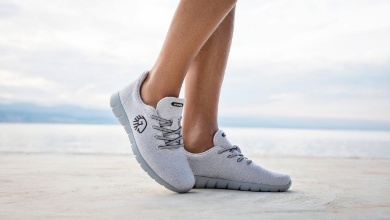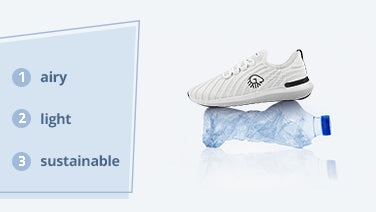

The History of Sneakers
The history of sneakers has an early beginning and they’ve been around longer than you think. Today, the sneaker is here, there, and everywhere. You wear them to work, play sports and go running, to school, out in the evenings to restaurants - today there is no event where these shoes don’t fit in. With the most popular global icons partnering and parading around in some of the world's most recognizable footwear brands, the sneaker actually had very humble beginnings.
SNEAKER ETYMOLOGY
The term ‘sneakers’ has been in use for well over a century now. In 1917, Henry Nelson McKinney, as US advertiser used the term because their rubber soles made the shoe’s wear quieter and stealthier, as if they were sneaking.
Learn more about why sneakers are called sneakers in our quick-read blog post. You may also pick up a few more terms too!
THE HISTORY OF SNEAKERS: WHERE IT ALL BEGAN
In 1870, the first sneakers with flexible rubber soles and a distinctive horizontal line on the edge of the sole became known as plimsolls. The name and appearance were inspired by the inventor of the load line on ships, Samuel Plimsoll. Due to their comfort, they were particularly popular with holidaymakers and athletes. However, the shoes had one drawback at the time: the left foot could not be distinguished from the right foot. Charles Goodyear recognised the trend, developed the plimsolls further and gave them a vulcanised rubber sole. The first sneaker company was founded in 1886. Interest grew and trainers became the ideal companion for leisure and outdoor activities.
MORE AND MORE PEOPLE WANT SNEAKERS
Thanks to high demand, sneakers were already in mass production by 1917. In the same year, the famous Converse All-Stars, named after the founder Marquis Converse, were born. With the support of Indiana Hoops star player Chuck Taylor, they became a sales hit. Now they are the best-selling basketball sneakers of all time. After the First World War, the US sneaker market was constantly evolving. Boys and girls queued for hours to buy the same sneakers as their sports idols.
SNEAKERS CONQUER THE 1936 OLYMPIC GAMES
The 1936 Olympic Games in Berlin provided the perfect occasion to increase the worldwide popularity of the sneakers. The entire US basketball team wore Converse during the competition. The US runner Jesse Owen won four gold medals in running shoes from Adolf Dassler, the founder of the sports brand Adidas. Adidas business boomed as a result of the athlete's performance and 200,000 pairs were sold every year. The 1940s saw the development of many new sneaker brands that still exist today, such as New Balance, Fila, Gola, Wilson, Mizuno and many others.
AFTER THE SECOND WORLD WAR
From the 1940s onwards, attitudes towards trainers changed. For the younger generation, trainers were now seen as a fashion statement. More and more new brands such as Diadora, Onitsuka Tiger and Puma became established. During the 50s, leisure activities became an important part of life. Dress codes in schools became more relaxed and trainers were even allowed to be worn to school. 10 years later, in 1960, two of the world's most recognisable brands were born: Nike and Vans. In 1960, the first running shoe with a corrugated sole, the New Balance Trackstar, went into mass production. It was the perfect time, because jogging was more popular than ever in the 1970s. As a result, more trainers were designed for various sports such as football, basketball and many more.
IT’S A SNEAKER WORLD
In the 80s and 90s, brands became increasingly popular, sales figures rose and sneakers appealed to the tastes of the masses. Brands such as Nike, Adidas and Reebok made a name for themselves through celebrity endorsements. Trends influenced design, patterns and colours. The successful partnership between basketball player Michael Jordan and Nike, from which the Nike Air Jordans emerged, began in 1980. To this day, they are among the most famous sneakers in the world and generate enormous sales. Prices also rose during this time: Nike Air 1s, Nike Air Jordans and Reebok Pumps exceeded the $100 mark for the first time. Competition between companies became tougher. The focus shifted to marketing and huge budgets were used to differentiate themselves from other manufacturers. Collaborations with sports stars and other celebrities helped to market trainers as a fashion statement.
SNEAKERS TODAY
With the new millennium came even more brands, sports collaborations and fashion houses that adopted the sneaker style. Nike bought Converse, Adidas bought Reebok. Brands started to collaborate with singers or rappers like Jay Z or Kanye West. The "Yeezys" trainers from Kanye West and Adidas became a real bestseller! Whether for leisure or sport, sneakers have become an integral part of everyday life, shopping centres and online shops. This is also shown by Google searches for the term "sneakers":
The value of sneakers has skyrocketed since 2010. Over €100 for a pair of trainers is no longer a rarity. Record sales have been achieved. The sneaker market will continue to grow strongly and, according to forecasts, is expected to reach over €85 billion by 2025.
INTRODUCING GIESSWEIN SNEAKERS
At Giesswein, wool is our game. Our wool sneakers range covers everyday wear, running, as well as high performance sports. Whether you’re after fashion or activewear, our women's sneakers and men's sneakers collections have something to please all.

Our 100% wool sneakers ensure your feet are warm in winter, and cool in summer thanks to the natural wool properties. Plus, our unique 3D stretch technology means we’ve crafted wool runners that work amazingly well as a running shoe, or as a day-to-day sneaker.
WHO ARE GIESSWEIN?
We are a family founded business now run by third generation Giessweins. It’s our mission to reinvent the positive attributes of wool to create unique products that you will love at first sight. We pride ourselves on hand-picking wool qualities in accordance with high ethical and ecological standards. With our wool knowledge, we’ve become Europe's largest producer of 100% virgin wool clothing which includes men’s, women’s, and children’s ranges spanning footwear, clothing, and more.

















